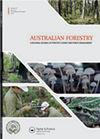减少燃料燃烧对减缓硬叶林野火的有效性
IF 1.2
4区 农林科学
Q3 FORESTRY
引用次数: 21
摘要
2019 - 2020年火灾季节,澳大利亚东南部的野火是近年来最严重的火灾之一。减少燃料燃烧作为一种风险缓解战略的有效性再次受到审查。一些人认为需要更多的减少燃料的燃烧,而另一些人则认为在这种极端的火灾中使用有限。在这项研究中,我们测试了在景观尺度上减少燃料燃烧的有效性,以降低随后野火的严重程度。为了实现这一目标,我们选择了新南威尔士州和维多利亚州最近(2015-2019年)进行的所有与2019-20年野火范围相交的减燃燃烧,并评估了最近处理过的地区的火灾严重程度是否与附近类似未处理地区的火灾严重程度有显著差异。为了确定火灾严重程度,使用了哨兵2号卫星图像和归一化燃烧比的变化(用于快速和广泛火灾严重程度制图的常用度量)。我们的研究结果显示,最近307次减少燃料燃烧中,有48%的火灾严重程度在统计上显著降低。我们的研究结果还表明,最近的减油烧伤产生了更大的影响,2019年66%的烧伤显著降低了严重程度,而2015年这一比例为42%。我们还在一系列指标(包括地点、海拔、坡度、坡向和森林异质性)的背景下分析了每一次减少燃料的燃烧,以评估这些因素是否会影响燃烧有效的可能性。地理位置和森林异质性在较小程度上是重要因素。我们的研究结果支持了最近减少燃料燃烧降低火灾严重程度的观点。然而,目前尚不清楚,在极端条件下,当野火主要由天气驱动,而不考虑燃料负荷时,这种差异是否会在操作上显著。本文章由计算机程序翻译,如有差异,请以英文原文为准。
The effectiveness of fuel reduction burning for wildfire mitigation in sclerophyll forests
ABSTRACT The wildfires in south-eastern Australia in the 2019–20 fire season were some of the worst in recent memory. The effectiveness of fuel-reduction burning as a risk mitigation strategy is, once again, being scrutinised. Some argue that more fuel-reduction burning is needed, while others suggest that it is of limited use in such extreme fires. In this study, we tested the effectiveness of fuel-reduction burning at a landscape scale in terms of its ability to reduce the severity of subsequent wildfire. To achieve this, we selected all the recent (2015–2019) fuel-reduction burns undertaken in New South Wales and Victoria that intersected with the extent of the 2019–20 wildfires and evaluated whether the fire severity was significantly different in the recently treated areas to that of similar untreated areas in the vicinity. To determine fire severity, Sentinel 2 satellite imagery and the change in normalised burn ratio (a common metric used for rapid and broadscale fire severity mapping) was used. Our results showed that 48% of the 307 recent fuel-reduction burns resulted in statistically significant decreased fire severity. Our results also indicated that more recent fuel-reduction burns had a greater impact, with 66% of burns undertaken in 2019 significantly reducing severity, compared with 42% from 2015. We also analysed each fuel-reduction burn in the context of a range of metrics, including location, elevation, slope, aspect and forest heterogeneity, to assess whether these factors influenced the likelihood that a burn would be effective. Location and, to a lesser degree, forest heterogeneity were found to be significant factors. Our results support the view that recent fuel-reduction burns reduce fire severity. It is unclear, however, whether the differences would be operationally significant under extreme conditions, when wildfires are driven largely by weather, irrespective of fuel loads.
求助全文
通过发布文献求助,成功后即可免费获取论文全文。
去求助
来源期刊

Australian Forestry
FORESTRY-
CiteScore
3.70
自引率
4.80%
发文量
15
审稿时长
>12 weeks
期刊介绍:
Australian Forestry is published by Taylor & Francis for the Institute of Foresters of Australia (IFA) for scientific, technical, and professional communication relating to forestry in the Asia Pacific.
 求助内容:
求助内容: 应助结果提醒方式:
应助结果提醒方式:


